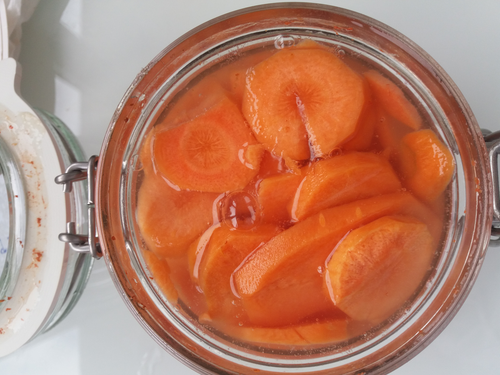
MARSIT Souhir
- Biologie, Chimie et Géographie, Université du Québec À Rimouski, Québec, Canada
- Genomic and evolutionary studies, Microbial (eco)physiology and metabolism
- recommender
Recommendation: 1
Reviews: 0
Recommendation: 1

The cutting type of vegetables influences the spontaneous fermentation rate
Cutting Type as a Key Factor in shaping Microbial Dynamics during Vegetable Fermentation
Recommended by Souhir Marsit based on reviews by Thibault Nidelet and Kate HowellFermented vegetables, traditionally consumed in Asian and Eastern countries, are gaining increasing interest in Western countries due to the growing demand for more natural, healthy, and sustainable food. Their potential health effects have only recently begun to be scientifically studied (Thierry et al., 2023).
The manufacturing process of fermented vegetables consists of cutting and packing raw vegetables with salt or brine, that will draw water and nutrients out from the vegetable tissue, thus providing microorganisms with the necessary substrates to initiate spontaneous fermentation (Buckenhueskes, 2015). Various parameters, including the cutting method, which may influence the rate of solute diffusion from vegetable tissue, can affect fermentation speed and, consequently, the quality of fermented vegetables. However, the role of cutting type has rarely been addressed.
The study by Valence et al. (2025) used a comprehensive range of methods to investigate how cutting types and a slight reduction in salt concentration influence the spontaneous fermentation of two vegetables, carrot and cabbage. Two cutting types, finely or roughly cut, and two salt levels, 1% (the minimum concentration usually used) and a lower salt level in line with health recommendations (0.8%), were tested. Carrot and cabbage fermentations were performed under controlled conditions in duplicate, and microbiological and biochemical characteristics were monitored over one month by combining several approaches and extensive experiments in culturomics, 16S rRNA gene and gyrB metataxonomics for bacterial community analysis, and targeted metabolomics.
The study shows the sequential establishment of microbial communities during the fermentation of both vegetables. In the early stages, Enterobacteriaceae replaced the initial microbiota, but they were rapidly outcompeted by Lactic Acid Bacteria (LAB). LAB growth acidified the medium, inhibiting enterobacteria and ensuring microbial safety. Their dominance was attributed to their ability to ferment carbohydrates into lactic acid and possibly the production of antimicrobial compounds. The results of targeted metabolomic analysis show that the main fermentation byproducts are mannitol, lactic acid, and acetic acid, which is consistent with previous studies on fermented vegetables.
Most notably, this study demonstrated for the first time that the type of vegetable cutting has a major impact on fermentation dynamics by influencing the release of solutes into the brine. Finer cuts, which provide a greater surface area, facilitate nutrient diffusion, thereby promoting LAB proliferation and acidification.
The study also shows that salt addition improved solute release, though the microbial effects were less clear due to variability between replicates. Indeed, significant variability between jars was noted, affecting microbial composition, metabolite profiles, and acidification rates.
The work of Valence et al. (2025) highlights for the first time the crucial role of cutting type in vegetable fermentation, demonstrating that finer cuts accelerate acidification, improve microbial safety, and enhance fermentation efficiency. Their findings contribute to the optimization of fermentation processes, providing valuable insights for enhancing the quality of fermented vegetables.
References:
Buckenhueskes HJ. Quality improvement and fermentation control in vegetables. Advances in Fermented Foods and Beverages. Elsevier, 2015, 515–39. https://doi.org/10.1016/B978-1-78242-015-6.00022-0
Thierry A, Baty C, Marché L, Chuat V, Picard O, Lortal S, Valence F. Lactofermentation of vegetables: An ancient method of preservation matching new trends. Trends Food Sci Technol. 2023. https://doi.org/10.1016/j.tifs.2023.07.009
Valence F, Junker R, Baty C, Rué O, Mariadassou M, Madec M, Maillard M, Bage A, Chuat V, Marché L, Thierry A. The cutting type of vegetables influences the spontaneous fermentation rate. HAL, ver.2 2025. https://hal.science/hal-04701063v2